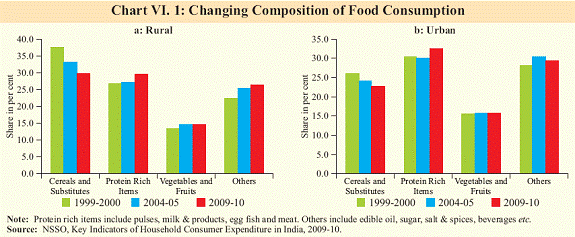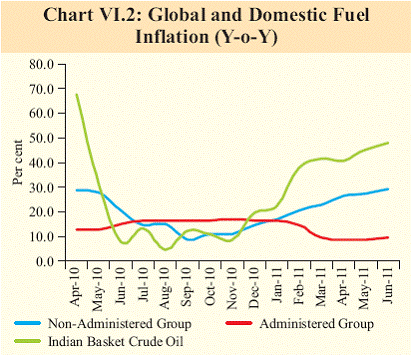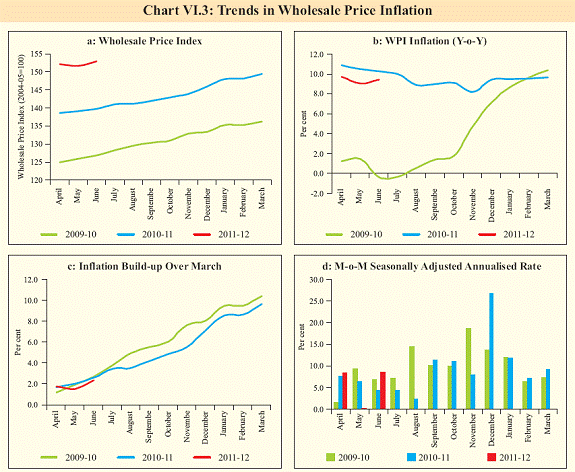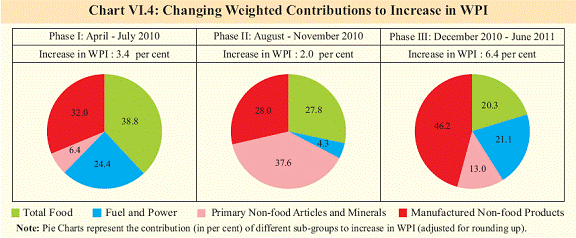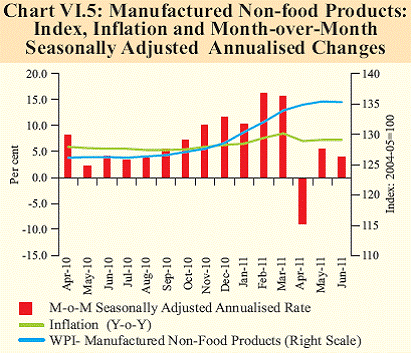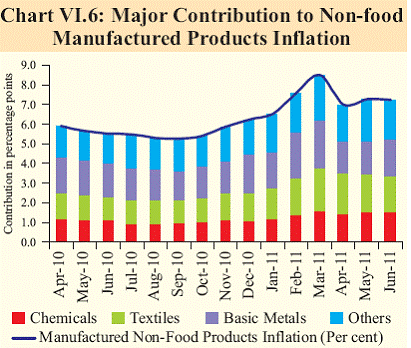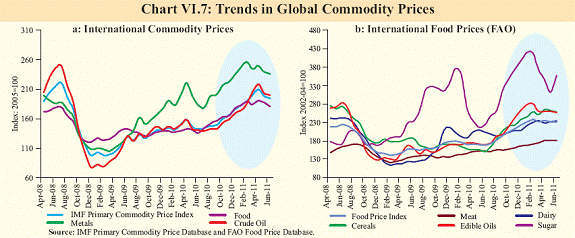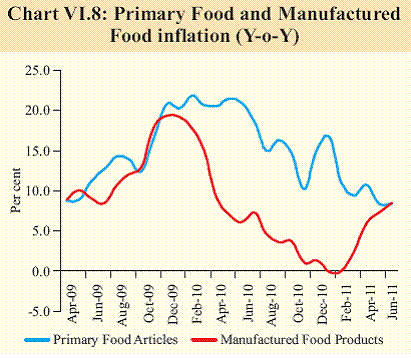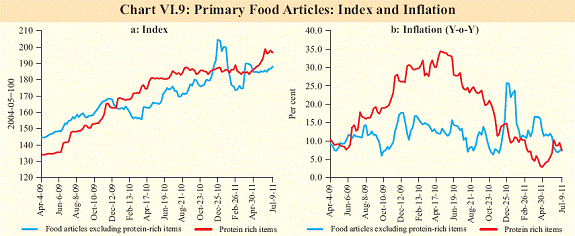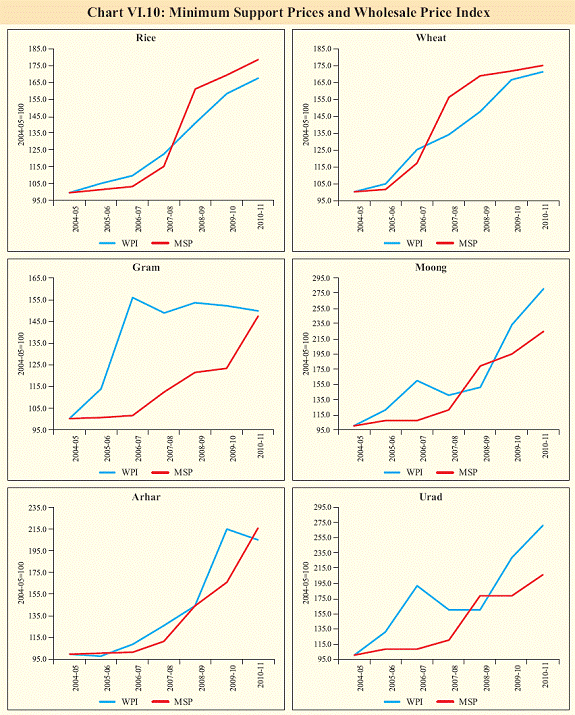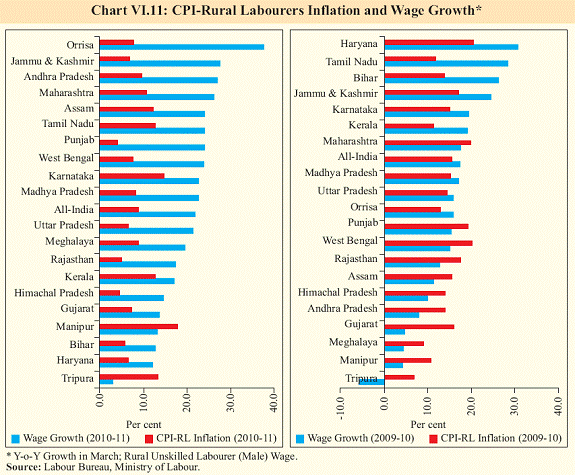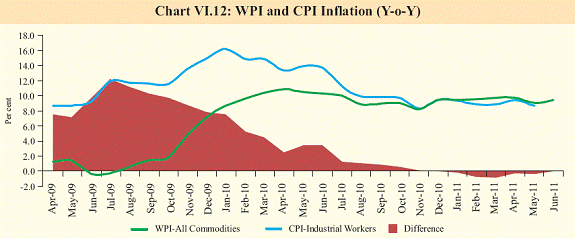VI. Price Situation - RBI - Reserve Bank of India
VI. Price Situation
In line with the projection made in the Annual Policy statement, inflation remained high in Q1 of 2011-12. The revision in fuel prices effected in June 2011 was factored in the projected inflation path which reduces, but does not fully eliminate the suppressed inflation risks. Softening of global commodity prices may provide some respite in the short-run. The favourable impact of a near normal monsoon on food inflation, however, could be offset by hike in minimum support prices. Non-food manufactured products inflation remains significantly higher than the long-term average of about 4 per cent, and reflects the persistence of pricing power. Apart from supply-side factors, demand pressures need to soften further for containing inflation. Price pressures are expected to persist through Q2 as well and then moderate in the later part of 2011-12. Near-term upside risks to inflation remain significant VI.1 Inflationary pressures persisted during Q1 of 2011-12 (9.4 per cent y-o-y, provisional in June 2011), reflecting transmission of global commodity prices to domestic inflation as well as increase in manufactured product prices on account of sustained input cost pressures. Producers were able to considerably pass on high costs amidst strong consumption demand. Global commodity prices exhibited some moderation in the recent period. However, as administered fuel prices were not raised earlier when global prices had risen sharply, a revision of fuel prices became inevitable and was effected on June 25, 2011. Even after this revision the pass-through is incomplete and remains a source of upside risk during the year. VI.2 For many other commodities passthrough remains incomplete, limiting the possibility of domestic prices falling in tandem with softening global prices. On the other hand, should global commodity prices start firming up again there will be further pressure on domestic prices. In any case, sticky administered prices pose a fiscal risk as they entail larger subsidies. They are also a source of inflation in the medium-to-long run as they dampen supply response by keeping interest rates high and resulting in a drag on investment. There are other sources of likely price pressures during the course of the year. Utility prices, especially electricity, may need to be revised up to cover costs. Domestic fertiliser prices still remain disconnected with higher prices of imported fertilisers and fertiliser inputs. Large discrete changes in administered prices also affect inflation expectations. VI.3 Primary food articles inflation moderated to 9.1 per cent in Q1 of 2011-12 from over 20 per cent level seen in Q1 of 2010-11, largely reflecting base effect as index levels continued to increase reflecting the structural character of inflation especially in protein rich items. Latest data available from NSSO quinquennial consumer expenditure survey (2009-10) suggests that there has been a secular shift in dietary pattern towards protein rich food items, both in rural and urban areas. Price pressures in these items could continue in the absence of supply response, as was seen in recent years (Chart VI.1). Renewed pressures may also come from revision in Minimum Support Prices (MSP). Non-food manufactured products inflation persisted at very high levels compared to its historical average and may persist as cost pressures and pricing power remain significant.
Administered price revisions and increase in freely priced fuel products keep fuel inflation high VI.4 The suppressed inflation concern, expressed in this Report in the preceding quarter came to roost, but this price adjustment is a significant step forward in strengthening the macroeconomic position of the Indian economy. Pass-through of international crude prices to domestic inflation has been significant in the recent period with most of the items under the freely priced category registering increases (Chart VI.2). International crude oil prices, though registered some decline in recent months, remain elevated as compared to the previous year. VI.5 As domestic administered prices of fuel products were kept unchanged for one year, this had led to substantial increase in the magnitude of under recoveries leading to corresponding large increase in fiscal burden. On June 25, 2011 the Government decided to increase the price of diesel by `3 per litre, PDS kerosene by `2 per litre and of domestic LPG by `50 per cylinder and reduce the excise as well as custom duties to partly address the issue of under recoveries. The direct impact of this increase on WPI inflation was 0.7 percentage points. Given that monthly WPI is an average of weeks, the full impact of this increase would be seen in the WPI for the month July 2011, as the price revision was effected in the last week of June 2011.
Inflation still driven by both cost-push and demand-side pressures VI.6 The generalisation of inflation with significant cost-push and demand side factors driving price changes in non-food manufacturing commodities has extended into Q1 of 2011-12. The wholesale price index (WPI) has continued its uptrend during 2011-12 so far even though year-on-year WPI inflation declined marginally in April 2011, owing to the high base. Inflation edged up in May and June 2011 reflecting continued price pressures. This was corroborated by the month over month seasonally adjusted changes which remained significantly positive during the recent period (Chart VI.3). The m-o-m rate of change in WPI suggests that the build-up of price pressures has varied significantly over months, but remained positive in almost every successive month.
VI.7 Importantly, the underlying drivers of increase in WPI changed considerably over three phases since March 2010. Price rise since December 2010 reflects generalisation of the inflationary pressures as also the dominant contribution from non-food manufactured products inflation (Chart VI.4). The food group had the highest contribution to the increase in WPI during the first phase (between April and July 2010). Primary non-food articles, particularly fibres like raw cotton, raw jute and raw silk had the dominant contribution in the second phase (between August and November 2010). It may also be noted that, the contribution of food group to overall increase in WPI has declined over successive phases.
Non-food manufactured products inflation key to inflation concern VI.8 The significant pick-up in non-food manufactured products inflation since December 2010 has been largely driven by passthrough of input cost pressures to output prices. Without the presence of demand pressures, the generalisation process would not have sustained over successive months. High month-overmonth seasonally adjusted inflation indicates that the price pressures have been almost continuous (Chart VI.5). VI.9 Textiles, chemicals and metals continue to contribute to most of the increase in manufactured non-food products (Chart VI.6). Input cost pressures have been significant for these products. Any moderation in manufactured non-food products inflation therefore would require both easing of pressures from input cost side as well as demand. Electricity price inflation remains moderate but given the increases in coal and mineral oils prices, electricity prices are likely to rise in the near-term.
Inflation surprise in advanced countries changes global inflation dynamics VI.10 Inflation emerged as a key policy concern in the global economy in recent months as increase in commodity prices spilled over to headline inflation. The World Economic Outlook Update (June 2011) of the IMF revised upwards the projection of inflation for 2011 for advanced economies to 2.6 per cent (from 2.2 per cent earlier projected in April 2011) while for emerging economies it was kept unchanged (6.9 per cent). Though core inflation in advanced economies remains subdued indicating absence of significant pressures from domestic demand, headline inflation has exceeded the target level for most inflation targeting economies. The divergence in inflation between advanced and emerging economies is both on account of higher share of food and fuel in total consumption basket as well as buoyant demand due to faster recovery in EMEs. The increase in unit labour costs in EMEs is being seen as a risk to global price stability because of the growing internationalisation of supply chains. VI.11 Subdued core inflation provided the space to most advanced economies to continue with accommodative monetary policy. The BIS, in its annual report 2010-11, however, cautions that the degree of global economic slack may be much less than what is generally believed and hence, inflationary pressures could stem from global recovery running into capacity constraints. Accommodative monetary policy conditions also entail the risk of adding to commodity price pressures. Most central banks of advanced economies continue to pursue policy rates at near zero/very low levels, while emerging economies have gradually tightened monetary policy to contain inflation pressures (Table VI.1). Commodity prices ease with global growth weakening, unclear if this is transitory VI.12 Global commodity prices have exhibited some decline in the Q1 of 2011-12, largely driven by improved supply prospects as well as some unwinding of investment positions in commodity futures market by financial investors. Crude oil prices moderated on the back of 28 International Energy Agency (IEA) member countries agreeing to release 60 million barrels of oil in July 2011 (Chart VI.7). Food prices have also moderated somewhat as supply response to high prices are expected to be good along with removal of trade restrictions by a number of countries. However, the prices continue to rule at significantly high levels. VI.13 Declining stocks in many key commodities also indicate that the price decline seen recently may not sustain for a prolonged period of time. The FAO-OECD Agricultural outlook for 2011-20 indicates that short-term supply response may temporarily ease price pressures but food prices “... on an average are projected to remain on a higher plateau compared to the previous decade in both nominal and real terms.” Rising income, diversification of dietary pattern to more protein-rich items as well as attraction of bio- fuel as an alternative source of energy could contribute to market tightness.
Food inflation declines significantly, but seasonal and structural factors still important VI.14 Primary food articles inflation declined significantly over past few months, barring December 2010-January 2011 when the trend reversed temporarily (Chart VI.8). The decline, however, has not been significant enough to ease the concern on food inflation. Moreover, it largely reflects the base effect, since food price levels continue to be high (Chart VI.9). Moreover manufactured food products inflation, which declined sharply during 2010-11 has reversed course in recent months. This is mainly led by increase in prices of edible oils, milk products and tea & coffee indicating that the past increases in primary food prices are getting reflected in manufactured food price increases, with a lag.
Near normal monsoon may not ease pressure on food inflation. VI.15 A near normal monsoon is generally expected to have a softening impact on prices of food articles, but some risks to food inflation have emerged. The recent increases in Minimum Support Prices (MSPs) for key agricultural commodities, though it aims at protecting producers from price risk, could in turn have some inflationary impact. It has been observed that the trend in prices of food articles more or less follows the increase in MSPs, with MSPs providing the floor to market prices (Chart VI.10). VI.16 Since a cost-plus pricing approach underpins revisions in MSPs, trends in input costs and rural wages provide lead information about expected path of food inflation. Increases in wages in rural areas could also put pressure on food prices both from demand and supply side. While increase in wages push up cost of production for agriculture, higher wage income is expected to provide purchasing power which could translate to higher demand, thereby pushing up prices. It has been observed that during 2010-11 the increase in wages for rural unskilled labourers have been on an average much higher than the increase in prices (state wise CPI- Rural Labourers inflation) indicating possibility of further pressure on prices going forward from higher wages (Chart VI.11).
VI.17 During Q1 of 2011-12, prices of nonfood primary articles showed moderation as raw cotton prices declined significantly both on account of favourable production and decline in international prices. A major contributor to manufactured non-food products inflation in recent months has been textiles, tracking past increase in raw cotton and fibres prices. The recent trend of declining cotton prices, however, could lead to moderation in inflation for textiles too. Among the minerals group, the crude petroleum index was revised upwards significantly by 34.4 per cent effective second week of April 2011, reflecting lagged reporting of past increases in prices of domestic crude oil. This alone raised WPI inflation by about 0.4 percentage points. CPI and WPI inflation converge with generalisation of price pressures VI.18 Various measures of CPI inflation remained in the range of 8.7-9.3 per cent in May/ June 2011. The convergence of various measures of CPI inflation with WPI inflation reflect moderation of food prices and increase in non-food manufactured products inflation (Chart VI.12). VI.19 The new CPI introduced for urban and rural areas along with a composite All-India CPI suggest continued price pressures with the latest reading of 108.8 (provisional) for June 2011 (base: 2010=100). This new Consumer Price Index for ‘rural’, ‘urban’ and ‘combined’ introduced since January 2011 is a major initiative to improve price statistics. The introduction of new CPIs provides a nationwide price index which is more comprehensive in coverage across regions as well as commodity groups. A comparison of the new CPI series against the existing series suggests that while the weight of food group has declined significantly for both rural and urban groups, the miscellaneous group, largely services, has increased in share. As year-onyear inflation data based on the new CPI become available from January 2012, it will be closer to the measure of inflation that is being commonly used in other countries for the conduct of monetary policy. However, long time series data, especially for the back period would not be available for these new indices, which limits the suitability of the data for policy analysis in the near-term. Inflation may moderate gradually due to structural constraints VI.20 Responding to persistent high inflation and increasing generalisation of price pressures, the Reserve Bank has significantly raised its emphasis on containing inflation. The impact of the anti-inflationary measures through expected moderation in demand, however, faces resistance from commodity price and wage inflation, which constantly add to price pressures. The softening of global commodity prices could be temporary. If the accommodative monetary policy stance of advanced economies continues, commodity price pressures are likely to resurface. Recent trends in minimum support prices and rural wages suggest that given their conditioning influence on food inflation, a near normal monsoon may not ease food inflation significantly.
VI.21 With overshooting of the fiscal deficit target a possibility, its expansionary impact on demand could partly offset the moderation in demand resulting from anti inflationary monetary actions and weaken monetary policy effectiveness. High inflation over several months has not led to price induced supply response in many critical commodities; in turn input cost pressures have spilled over to output prices. These trends necessitate structural reforms to enhance supply response while antiinflationary bias of monetary policy anchors inflation expectations.
|
|||||||||||||||||||||||||||||||||||||||||||||||||||||||||||||||||||||||||||||||||||||||||||||||||||||||||||||||||||||||||||||||||||||||||||||||||||||||||||||||||||||||||||||||||||||||||||||||||||||||||||||||












